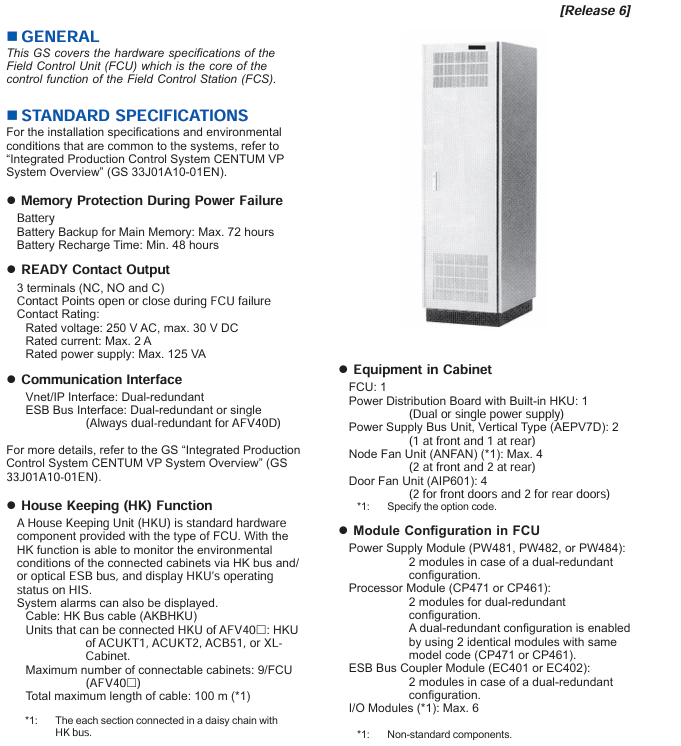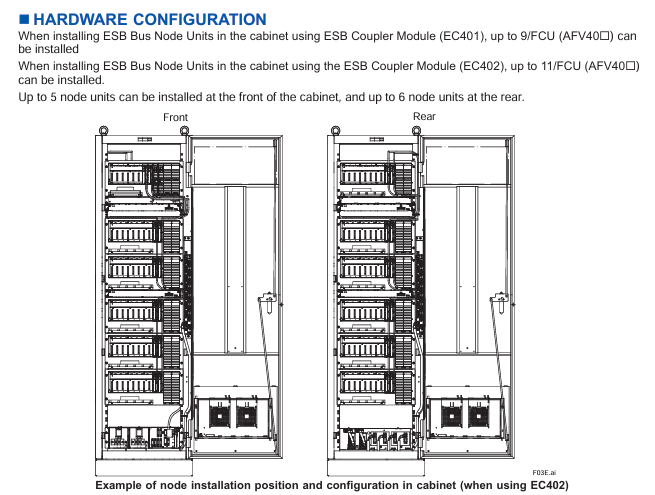Yokogawa AFV40S/AFV40D Field Control Unit (FCU)
Differentiated design: AFV40S is a single configuration unit suitable for non safety critical scenarios; AFV40D is a dual redundant configuration (with redundant power supply, processor, and communication bus), suitable for critical control circuits that require extremely high reliability, such as reactor temperature control and emergency shutdown systems.
environmental adaptability
Working temperature: -10 ℃~+50 ℃ (depending on the cabinet door fan and node fan for heat dissipation); Storage temperature: -20 ℃~+60 ℃.
Protection level: IP20 (only applicable to internal components of the cabinet, must be installed in a closed cabinet to avoid direct contact with dust and liquids).
Anti interference: Compliant with industrial electromagnetic compatibility (EMC) standards, refer to the CENTUM VP system overview document (GS33J01A10-01EN) for details.

Installation restrictions and configuration requirements
(1) Node unit expansion restrictions
Number and type of nodes
A single FCU can support up to 13 node units, including ESB bus node units (ANB10 series) and optical ESB bus relay module units (ANT10U), and can install up to 11 units in the cabinet (5 in the front and 6 in the back).
Remote node expansion: It needs to be connected through the optical ESB bus relay main module (ANT401/ANT411), and the relay module needs to be installed in slots 1-6 of the FCU (dual redundant configuration needs to be installed in pairs, single configuration needs to be installed in the order of slots 1, 3, and 5). The maximum transmission distance of the optical fiber cable is 50km.
Fan unit selection rules
The number of node fan units (ANFAN) should be determined based on the total number of node units in the cabinet to ensure sufficient heat dissipation and avoid module overheating
Number of required node fan units for the total number of node units (ANB10+ANT10U) in the cabinet
0-4 1
5-9 2
10 3
11 4
(2) Hardware Installation Specification
Cabinet grounding and wiring
Power wiring: M6 screw terminals are used, supporting dual power systems (main/backup power needs to be distinguished), and the input voltage should be consistent with the suffix code (such as 100-120V AC or 24V DC).
Grounding requirements: Use M8 screw terminals, with a protective grounding (PE) resistance of ≤ 4 Ω, to ensure the safety of personnel and equipment in case of leakage.
READY contact wiring: M4 screw terminals are used, and NC/NO contacts need to be selected according to the requirements of external alarm devices.
Module installation sequence
The node units inside the cabinet need to be installed in the order of "ANB10 series (ESB bus nodes) first, then ANT10U (optical ESB relay units)" to avoid communication conflicts.
The dual redundant modules (power supply, processor, ESB coupler) need to be installed in adjacent slots to ensure synchronization of redundant switching signals.
Cable restrictions
HK bus cable (AKBHKU): total length ≤ 100 meters. When connecting multiple cabinets in a daisy chain, the length of each cable segment needs to be included in the total length.
ESB bus cable (YCB301): The pre wiring inside the cabinet has been completed, but the cable between ANB10 and ANT10U needs to be connected on site, and parallel laying with power cables should be avoided (spacing ≥ 300mm) to reduce electromagnetic interference.

Model code and configuration options
(1) AFV40S (Single Field Control Unit) Model Code
Model format: AFV40S - [suffix code 1] [suffix code 2] [suffix code 3] [suffix code 4] [suffix code 5] [suffix code 6] [suffix code 7]+option code Core suffix code meaning:
Description of optional values for suffix code bits
1 (Type) A/S A=compatible with CP471 processor (R6.05 and above); S=Compatible with CP461 processor (default)
2 (Vnet/IP) 3/4 3=dual redundant Vnet/IP+single power supply; 4=Dual redundant Vnet/IP+dual power supply
3 (ESB bus) 1/2/3/4 1=single ESB (EC401 × 1); 2=Dual redundant ESB (EC401 × 2); 3=Single ESB (EC402 × 1); 4=Dual redundant ESB (EC402 × 2)
5 (power type) 1/2/4 1=100-120V AC; 2=220-240V AC; 4=24V DC
Option code (optional as needed):
/ - S1F: Single ESB bus node unit (single power supply, model ANB10S-3 5), is the number of units (1-9/A=10/B=11).
/ - FAN: Node Fan Unit (ANFAN), is the number of fans (1-4, determined by the total number of nodes).
/CH: Channel base with cable holes (rear 300 × 40mm hole, factory equipped with filling plate), but CE/RCM/EMC/KC certification cannot be selected at the same time after selecting this option.
/ATDOC: Includes explosion-proof manual (compliant with ATEX directive, applicable to potentially explosive environments).
(2) AFV40D (Dual Redundant Field Control Unit) Model Code
Model format: AFV40D - [suffix code 1] [suffix code 2] [suffix code 3] [suffix code 4] [suffix code 5] [suffix code 6] [suffix code 7]+Option code Core difference: AFV40D requires dual redundancy configuration, suffix code 2 is fixed as "4" (dual redundant Vnet/IP+dual power supply), suffix code 3 is fixed as "2/4" (dual redundant ESB bus), and option code only supports dual redundant node units (such as/ - D2F, dual redundant ESB node units).
Software requirements and compatible systems
software license
AFV40S/AFV40D require separate purchase of software license, core dependencies:
VP6F1700 Field Control Station Control Function License (GS33J15C10-01EN): Supports the control logic operation of CP461/CP471 processors.
VP6F3100 Project I/O License (GS33J15A10-01EN): Supports I/O node expansion and signal acquisition for FIO systems.
- EMERSON
- Honeywell
- CTI
- Rolls-Royce
- General Electric
- Woodward
- Yaskawa
- xYCOM
- Motorola
- Siemens
- Rockwell
- ABB
- B&R
- HIMA
- Construction site
- electricity
- Automobile market
- PLC
- DCS
- Motor drivers
- VSD
- Implications
- cement
- CO2
- CEM
- methane
- Artificial intelligence
- Titanic
- Solar energy
- Hydrogen fuel cell
- Hydrogen and fuel cells
- Hydrogen and oxygen fuel cells
- tyre
- Chemical fiber
- dynamo
- corpuscle
- Pulp and paper
- printing
- fossil
- FANUC
- Food and beverage
- Life science
- Sewage treatment
- Personal care
- electricity
- boats
- infrastructure
- Automobile industry
- metallurgy
- Nuclear power generation
- Geothermal power generation
- Water and wastewater
- Infrastructure construction
- Mine hazard
- steel
- papermaking
- Natural gas industry
- Infrastructure construction
- Power and energy
- Rubber and plastic
- Renewable energy
- pharmacy
- mining
- Plastic industry
- Schneider
- Kongsberg
- NI
- Wind energy
- International petroleum
- International new energy network
- gas
- WATLOW
- ProSoft
- SEW
- wind
- ADVANCED
- Reliance
- YOKOGAWA
- TRICONEX
- FOXBORO
- METSO
- MAN
- Advantest
- ADVANCED
- ALSTOM
- Control Wave
- AB
- AMAT
- STUDER
- KONGSBERG
- MOTOROLA
- DANAHER MOTION
- Bently
- Galil
- EATON
- MOLEX
- Triconex
- DEIF
- B&W
- ZYGO
- Aerotech
- DANFOSS
- KOLLMORGEN
- Beijer
- Endress+Hauser
- MOOG
- KB
- Moxa
- Rexroth
- YAMAHA
- Johnson
- Westinghouse


Email:wang@kongjiangauto.com


































































































































